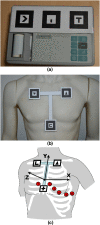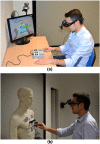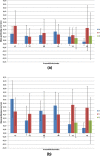Telemedicine supported by Augmented Reality: an interactive guide for untrained people in performing an ECG test
- PMID: 25413448
- PMCID: PMC4277827
- DOI: 10.1186/1475-925X-13-153
Telemedicine supported by Augmented Reality: an interactive guide for untrained people in performing an ECG test
Abstract
Background: In many telemedicine applications, the correct use of medical device at the point of need is essential to provide an appropriate service. Some applications may require untrained people to interact with medical devices and patients: care delivery in transportation, military actions, home care and telemedicine training.Appropriate operation of medical device and correct connection with patient's body are crucial. In these scenarios, tailored applications of Augmented Reality can offer a valid support by guiding untrained people at the point of need. This study aims to explore the feasibility of using Augmented Reality in telemedicine applications, by facilitating an acceptable use of biomedical equipment by any unskilled person. In particular, a prototype system was built in order to estimate how untrained users, with limited or no knowledge, can effectively interact with an ECG device and properly placing ECG electrodes on patient's chest.
Methods: An Augmented Reality application was built to support untrained users in performing an ECG test. Simple markers attached to the ECG device and onto patient's thorax allow camera calibration. Once objects and their pose in the space are recognized, the video of the current scene is enriched, in real-time, with additional pointers, text boxes and audio that help the untrained operator to perform the appropriate sequence of operations. All the buttons, switches, ports of the ECG device together with the location of precordial leads were coded and indicated. Some user's voice commands were also included to improve usability.
Results: Ten untrained volunteers, supported by the augmented reality, were able to carry out a complete ECG test first on a mannequin and then on a real patient in a reasonable time (about 8 minutes on average). Average positioning errors of precordial electrodes resulted less than 3 mm for the mannequin and less than 7 mm for the real patient. These preliminary findings suggest the effectiveness of the developed application and the validity of clinical ECG recordings.
Conclusion: This application can be adapted to support the use of other medical equipment as well as other telemedicine tasks and it could be performed with a Tablet or a Smartphone.
Figures







Similar articles
-
A Flexible 12-Lead/Holter Device with Compression Capabilities for Low-Bandwidth Mobile-ECG Telemedicine Applications.Sensors (Basel). 2018 Nov 5;18(11):3773. doi: 10.3390/s18113773. Sensors (Basel). 2018. PMID: 30400587 Free PMC article.
-
Implementation of a portable device for real-time ECG signal analysis.Biomed Eng Online. 2014 Dec 10;13:160. doi: 10.1186/1475-925X-13-160. Biomed Eng Online. 2014. PMID: 25491135 Free PMC article.
-
Sensitivity of CIPS-computed PVC location to measurement errors in ECG electrode position: the need for the 3D camera.J Electrocardiol. 2014 Nov-Dec;47(6):788-93. doi: 10.1016/j.jelectrocard.2014.08.005. Epub 2014 Aug 12. J Electrocardiol. 2014. PMID: 25194874
-
ECG by mobile technologies.J Electrocardiol. 2016 Nov-Dec;49(6):894-901. doi: 10.1016/j.jelectrocard.2016.07.030. Epub 2016 Jul 28. J Electrocardiol. 2016. PMID: 27524474 Review.
-
Toward personal eHealth in cardiology. Results from the EPI-MEDICS telemedicine project.J Electrocardiol. 2005 Oct;38(4 Suppl):100-6. doi: 10.1016/j.jelectrocard.2005.06.011. J Electrocardiol. 2005. PMID: 16226083 Review.
Cited by
-
Augmented reality in medical education: a systematic review.Can Med Educ J. 2020 Mar 16;11(1):e81-e96. doi: 10.36834/cmej.61705. eCollection 2020 Mar. Can Med Educ J. 2020. PMID: 32215146 Free PMC article. Review.
-
Method for Assessing the Influence of Phobic Stimuli in Virtual Simulators.J Imaging. 2023 Sep 25;9(10):195. doi: 10.3390/jimaging9100195. J Imaging. 2023. PMID: 37888302 Free PMC article.
-
Exploratory Application of Augmented Reality/Mixed Reality Devices for Acute Care Procedure Training.West J Emerg Med. 2018 Jan;19(1):158-164. doi: 10.5811/westjem.2017.10.35026. Epub 2017 Dec 14. West J Emerg Med. 2018. PMID: 29383074 Free PMC article.
-
Augmented Reality in Real-time Telemedicine and Telementoring: Scoping Review.JMIR Mhealth Uhealth. 2023 Apr 18;11:e45464. doi: 10.2196/45464. JMIR Mhealth Uhealth. 2023. PMID: 37071458 Free PMC article.
-
Augmented reality and mixed reality for healthcare education beyond surgery: an integrative review.Int J Med Educ. 2020 Jan 18;11:1-18. doi: 10.5116/ijme.5e01.eb1a. Int J Med Educ. 2020. PMID: 31955150 Free PMC article.
References
-
- Wootton R, Craig J, Patterson V. Introduction to telemedicine. 2. London: The Royal Society of Medicine Press Ltd; 2006.
-
- Norris AC: Essentials of Telemedicine and Telecare. John Wiley & Sons, Ltd. Published Online: 23 April 2002; Print ISBN: 97804715315; Online ISBN: 9780470846346; doi:10.1002/0470846348
MeSH terms
LinkOut - more resources
Full Text Sources
Other Literature Sources
Medical

